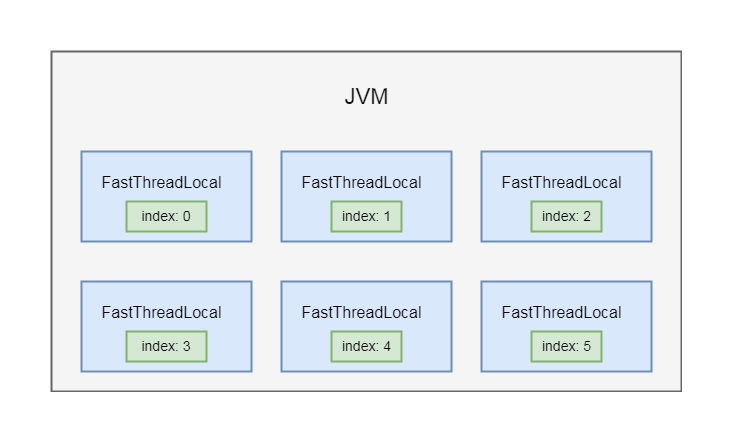您好,登錄后才能下訂單哦!
您好,登錄后才能下訂單哦!
這篇文章主要介紹“Netty的FastThreadLocal和Recycler實例分析”的相關知識,小編通過實際案例向大家展示操作過程,操作方法簡單快捷,實用性強,希望這篇“Netty的FastThreadLocal和Recycler實例分析”文章能幫助大家解決問題。
FastThreadLocal我們在剖析堆外內存分配的時候簡單介紹過, 它類似于JDK的ThreadLocal, 也是用于在多線程條件下, 保證統一線程的對象共享, 只是netty中定義的FastThreadLocal, 性能要高于jdk的ThreadLocal, 具體原因會在之后的小節進行剖析
Recyler我們應該也不會太陌生, 因為在之前章節中, 有好多地方使用了Recyler
Recyler是netty實現的一個輕量級對象回收站, 很多對象在使用完畢之后, 并沒有直接交給gc去處理, 而是通過對象回收站將對象回收, 目的是為了對象重用和減少gc壓力
比如ByteBuf對象的回收, 因為ByteBuf對象在netty中會頻繁創建, 并且會占用比較大的內存空間, 所以使用完畢后會通過對象回收站的方式進行回收, 已達到資源重用的目的
這一章就對FastThreadLocal和Recyler兩個并發工具類進行分析
public class FastThreadLocalDemo {
final class FastThreadLocalTest extends FastThreadLocal<Object>{
@Override
protected Object initialValue() throws Exception {
return new Object();
}
}
private final FastThreadLocalTest fastThreadLocalTest;
public FastThreadLocalDemo(){
fastThreadLocalTest = new FastThreadLocalTest();
}
public static void main(String[] args){
FastThreadLocalDemo fastThreadLocalDemo = new FastThreadLocalDemo();
new Thread(new Runnable() {
@Override
public void run() {
Object obj = fastThreadLocalDemo.fastThreadLocalTest.get();
try {
for (int i=0;i<10;i++){
fastThreadLocalDemo.fastThreadLocalTest.set(new Object());
Thread.sleep(1000);
}
}catch (Exception e){
e.printStackTrace();
}
}
}).start();
new Thread(new Runnable() {
@Override
public void run() {
try {
Object obj = fastThreadLocalDemo.fastThreadLocalTest.get();
for (int i=0;i<10;i++){
System.out.println(obj == fastThreadLocalDemo.fastThreadLocalTest.get());
Thread.sleep(1000);
}
}catch (Exception e){
}
}
}).start();
}
}這里首先聲明一個內部類FastThreadLocalTest繼承FastThreadLocal, 并重寫initialValue方法, initialValue方法就是用來初始化線程共享對象的
然后聲明一個成員變量fastThreadLocalTest, 類型就是內部類FastThreadLocalTest
在構造方法中初始化fastThreadLocalTest
main方法中創建當前類FastThreadLocalDemo的對象fastThreadLocalDemo
然后啟動兩個線程, 每個線程通過fastThreadLocalDemo.fastThreadLocalTest.get()的方式拿到線程共享對象, 因為fastThreadLocalDemo是相同的, 所以fastThreadLocalTest對象也是同一個, 同一個對象在不同線程中進行get()
第一個線程循環通過set方法修改共享對象的值
第二個線程則循環判斷并輸出fastThreadLocalTest.get()出來的對象和第一次get出來的對象是否相等
這里輸出結果都true, 說明其他線程雖然不斷修改共享對象的值, 但都不影響當前線程共享對象的值
這樣就實現了線程共享的對象的功能
根據上述示例, 我們剖析FastThreadLocal的創建
首先跟到FastThreadLocal的構造方法中:
public FastThreadLocal() {
index = InternalThreadLocalMap.nextVariableIndex();
}這里的index, 代表FastThreadLocal對象的一個下標, 每創建一個FastThreadLocal, 都會有一個唯一的自增的下標
public static int nextVariableIndex() {
int index = nextIndex.getAndIncrement();
if (index < 0) {
nextIndex.decrementAndGet();
throw new IllegalStateException("too many thread-local indexed variables");
}
return index;
}這里只是獲取nextIndex通過getAndIncrement()進行原子自增, 創建第一個FastThreadLocal對象時, nextIndex為0, 創建第二個FastThreadLocal對象時nextIndex為1, 以此類推, 第n次nextIndex為n-1, 如圖所示

8-1-1
我們回到demo中, 我們看線程中的這一句:
Object obj = fastThreadLocalDemo.fastThreadLocalTest.get();
這里調用了FastThreadLocal對象的get方法, 作用是創建一個線程共享對象
我們跟到get方法中:
public final V get() {
return get(InternalThreadLocalMap.get());
}這里調用了一個重載的get方法, 參數中通過InternalThreadLocalMap的get方法獲取了一個InternalThreadLocalMap對象
我們跟到InternalThreadLocalMap的get方法中, 分析其實如何獲取InternalThreadLocalMap對象的
public static InternalThreadLocalMap get() {
Thread thread = Thread.currentThread();
if (thread instanceof FastThreadLocalThread) {
return fastGet((FastThreadLocalThread) thread);
} else {
return slowGet();
}
}這里首先拿到當前線程, 然后判斷當前線程是否為FastThreadLocalThread線程, 通常NioEventLoop線程都是FastThreadLocalThread, 用于線程則不是FastThreadLocalThread
在這里, 如果FastThreadLocalThread線程, 則調用fastGet方法獲取InternalThreadLocalMap, 從名字上我們能知道, 這是一種效率極高的獲取方式
如果不是FastThreadLocalThread線程, 則調用slowGet方式獲取InternalThreadLocalMap, 同樣根據名字, 我們知道這是一種效率不太高的獲取方式
我們的demo并不是eventLoop線程, 所以這里會走到slowGet()方法中
private static InternalThreadLocalMap slowGet() {
ThreadLocal<InternalThreadLocalMap> slowThreadLocalMap = UnpaddedInternalThreadLocalMap.slowThreadLocalMap;
InternalThreadLocalMap ret = slowThreadLocalMap.get();
if (ret == null) {
ret = new InternalThreadLocalMap();
slowThreadLocalMap.set(ret);
}
return ret;
}首先通過UnpaddedInternalThreadLocalMap.slowThreadLocalMap拿到一個ThreadLocal對象slowThreadLocalMap, slowThreadLocalMap是UnpaddedInternalThreadLocalMap類的一個靜態屬性, 類型是ThreadLocal類型
這里的ThreadLocal是jdk的ThreadLocal
然后通過slowThreadLocalMap對象的get方法, 獲取一個InternalThreadLocalMap
如果第一次獲取, InternalThreadLocalMap有可能是null, 所以在if塊中, new了一個InternalThreadLocalMap對象, 并設置在ThreadLocal對象中
因為netty實現的FastThreadLocal要比jdk的ThreadLocal要快, 所以這里的方法叫slowGet
回到InternalThreadLocalMap的get方法:
public static InternalThreadLocalMap get() {
Thread thread = Thread.currentThread();
if (thread instanceof FastThreadLocalThread) {
return fastGet((FastThreadLocalThread) thread);
} else {
return slowGet();
}
}我們繼續剖析fastGet方法, 通常EventLoop線程FastThreadLocalThread線程, 所以EventLoop線程執行到這一步的時候會調用fastGet方法
private static InternalThreadLocalMap fastGet(FastThreadLocalThread thread) {
InternalThreadLocalMap threadLocalMap = thread.threadLocalMap();
if (threadLocalMap == null) {
thread.setThreadLocalMap(threadLocalMap = new InternalThreadLocalMap());
}
return threadLocalMap;
}首先FastThreadLocalThread對象直接通過threadLocalMap拿到threadLocalMap對象
如果threadLocalMap為null, 則創建一個InternalThreadLocalMap對象設置到FastThreadLocalThread的成員變量中
這里我們可以知道FastThreadLocalThread對象中維護了一個InternalThreadLocalMap類型的成員變量, 可以直接通過threadLocalMap()方法獲取該變量的值, 也就是InternalThreadLocalMap
我們跟到InternalThreadLocalMap的構造方法中:
private InternalThreadLocalMap() {
super(newIndexedVariableTable());
}這里調用了父類的構造方法, 傳入一個newIndexedVariableTable()
我們跟到newIndexedVariableTable()中:
private static Object[] newIndexedVariableTable() {
Object[] array = new Object[32];
Arrays.fill(array, UNSET);
return array;
}這里創建一個長度為32的數組, 并為數組中的每一個對象設置為UNSET, UNSET是一個Object的對象, 表示該下標的值沒有被設置
回到InternalThreadLocalMap的構造方法, 再看其父類的構造方法:
UnpaddedInternalThreadLocalMap(Object[] indexedVariables) {
this.indexedVariables = indexedVariables;
}這里初始化了一個數組類型的成員變量indexedVariables, 就是newIndexedVariableTable返回object的數組
這里我們可以知道, 每個InternalThreadLocalMap對象中都維護了一個Object類型的數組, 那么這個數組有什么作用呢?我們繼續往下剖析
public final V get() {
return get(InternalThreadLocalMap.get());
}我們剖析完了InternalThreadLocalMap.get()的相關邏輯, 再繼續看重載的get方法:
public final V get(InternalThreadLocalMap threadLocalMap) {
Object v = threadLocalMap.indexedVariable(index);
if (v != InternalThreadLocalMap.UNSET) {
return (V) v;
}
return initialize(threadLocalMap);
}首先看這一步:
Object v = threadLocalMap.indexedVariable(index);
這一步是拿到當前index下標的object, 其實也就是拿到每個FastThreadLocal對象的綁定的線程共享對象
index是我們剛才分析過, 是每一個FastThreadLocal的唯一下標
我們跟到indexedVariable方法中:
public Object indexedVariable(int index) {
Object[] lookup = indexedVariables;
return index < lookup.length? lookup[index] : UNSET;
}這里首先拿到indexedVariables, 我們剛才分析過, indexedVariables是InternalThreadLocalMap對象中維護的數組, 初始大小是32
然后再return中判斷當前index是不是小于當前數組的長度, 如果小于則獲取當前下標index的數組元素, 否則返回UNSET代表沒有設置的對象
這里我們可以分析到, 其實每一個FastThreadLocal對象中所綁定的線程共享對象, 是存放在threadLocalMap對象中的一個對象數組的中的, 數組中的元素的下標其實就是對應著FastThreadLocal中的index屬性, 對應關系如圖所示

8-1-2
回到FastThreadLocal重載的get方法:
public final V get(InternalThreadLocalMap threadLocalMap) {
Object v = threadLocalMap.indexedVariable(index);
if (v != InternalThreadLocalMap.UNSET) {
return (V) v;
}
return initialize(threadLocalMap);
}根據以上邏輯, 我們知道, 第一次獲取對象v是只能獲取到UNSET對象, 因為該對象并沒有保存在threadLocalMap中的數組indexedVariables中, 所以第一次獲取在if判斷中為false, 會走到initialize方法中
跟到initialize方法中:
private V initialize(InternalThreadLocalMap threadLocalMap) {
V v = null;
try {
v = initialValue();
} catch (Exception e) {
PlatformDependent.throwException(e);
}
threadLocalMap.setIndexedVariable(index, v);
addToVariablesToRemove(threadLocalMap, this);
return v;
}這里首先調用的initialValue方法, 這里的initialValue實際上走的是FastThreadLocal子類的重寫initialValue方法
@Override
protected Object initialValue() throws Exception {
return new Object();
}通過這個方法會創建一個線程共享對象
然后通過threadLocalMap對象的setIndexedVariable方法將創建的線程共享對象設置到threadLocalMap中維護的數組中, 參數為FastThreadLocal和創建的對象本身
跟到setIndexedVariable方法中:
public boolean setIndexedVariable(int index, Object value) {
Object[] lookup = indexedVariables;
if (index < lookup.length) {
Object oldValue = lookup[index];
lookup[index] = value;
return oldValue == UNSET;
} else {
expandIndexedVariableTableAndSet(index, value);
return true;
}
}這里首先判斷FastThreadLocal對象的index是否超過數組indexedVariables的長度, 如果沒有超過, 則直接通過下標設置新創建的線程共享對象, 通過這個操作, 下次獲取該對象的時候就可以直接通過數組下標進行取出
如果index超過了數組indexedVariables的長度, 則通過expandIndexedVariableTableAndSet方法將數組擴容, 并且根據index的通過數組下標的方式將線程共享對象設置到數組indexedVariables中
關于“Netty的FastThreadLocal和Recycler實例分析”的內容就介紹到這里了,感謝大家的閱讀。如果想了解更多行業相關的知識,可以關注億速云行業資訊頻道,小編每天都會為大家更新不同的知識點。
免責聲明:本站發布的內容(圖片、視頻和文字)以原創、轉載和分享為主,文章觀點不代表本網站立場,如果涉及侵權請聯系站長郵箱:is@yisu.com進行舉報,并提供相關證據,一經查實,將立刻刪除涉嫌侵權內容。